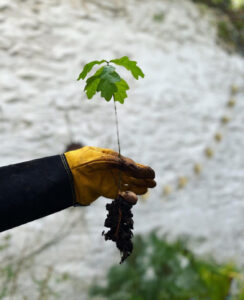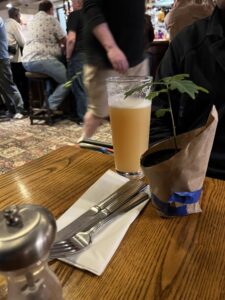For Lally Macbeth, 2023 was The Year of the Oak.

This year I have thought a lot about oaks. It’s not that I haven’t considered them in other years but in 2023 they have been more present than ever. At the tail end of last year, I woke to an act of brutality. Behind my house is a bank of earth that stretches up to the neighbouring house above. It is a wild and strange piece of land filled with three cornered leek in the Spring and Montbretia and Wood Sorrel in the Summer. It also was once home to an enormous and towering tree. I regret to say that I do not know what species this tree was but I did spend many mornings admiring its ability to block my view from the bedroom window through to the neighbour’s garden. It acted as a leafy cocoon if you will. A barrier between me and the row of houses that sit behind. On this ill-fated November morning its life was cut short. Two chainsaws hacked into its trunk and soon it was just a lifeless stump. To add insult to its death the neighbour came out some time later and trickled weed killer over it as if to ensure it was truly dead.
For months I mourned it. The cycle of my year had been altered. No longer could I measure the season by how many leaves I could see on the tree. The weed killer also had a detrimental effect on the rest of the bank; once verdant and full of life it was now barren and sad. I felt upset that I had never bothered to identify the tree. Maybe if I had properly befriended it, I could have fought for it. If I had known its name I could have screamed ‘Don’t do that, don’t you know that’s an English Oak!’ Screaming ‘Don’t do that, don’t you know that’s a tree’ doesn’t have quite the same effect.
In the Spring Matthew brings me two oaks back from Dorset. He has reared them from acorns that he gathered from the street. One is a Sessile Oak and the other an English Oak. He tells me that oaks can host up to 2,000 species. This seems amazing to me. I imagine this incredible hubbub of community; ants, wasps, flies, crows and magpies — buzzing and cooing, making nests and love, eating and living. We give the Sessile Oak to my mum and Matthew suggests planting the English Oak in the bank. As he makes the hole and plops the Oak in, I wonder how tall it will grow, according to google they can grow up to 40 metres. It’s hard to imagine this looking at this tiny baby Oak with its three leaves.
We check on the Oak each week and it grows. It lives. It is happy.
In April we visit Kingston near Lewes for a Caught by the River event. We interview our friend Alex Woodcock about his book King of Dust, and his life as a stonemason. At the back of the room Andrew and Diva are selling books, and Alex has instructed them that each copy of his book comes with a free Oak. Beneath the table of books is a box of Oak saplings ready to be carried away to new homes. At the end of the day Alex presents us with twin saplings in a pot. We take them to the pub and toast them with a pint of Harvey’s. Later on, they come back to the Premier Inn where we give them a small drink of water before placing them on the side table. The next morning, we leave our luggage in the left luggage room and the receptionist of the Premier Inn carefully places a tag around their trunks so we can reclaim them later.

Before we go home to Cornwall, we have to travel to Canterbury and Brighton. The Oaks come with us. They are now very well-travelled Oaks, traversing nearly 5 counties in their short lives. We keep them watered along the way. On the train we have to find them a table to keep them upright. Somewhere along the journey we name them: Gog and Magog.
Eventually we travel the long way home to Cornwall. We both feel amazed. The Oaks make it home in one piece. In fact, they have become an even more beautiful radiant green, it is like they know they have reached their end destination. They have come home. We place them on a table in the garden to become acclimatised.
In July we have news of an Oak that Matthew grew from acorn in Dorset. It resides in his old garden, a towering great English Oak, that has been in the earth for twelve years. It has weathered storm and deluge but in July its life is cut short. Sliced down in an instant. Its branches, and its careful acclimatised ecosystem no more. Another act of brutality. We talk about making a song called Oak Karma. Why would anyone kill a tree? And in particular an Oak! It seems monstrous. When you kill an Oak it’s not just the tree that dies but the whole community of creatures and wildlife that its branches, trunk and leaves support too. It is a massacre of nature.
As I write now Gog and Magog still sit on the table, waiting for a ‘forever home’. Where they will end up is uncertain but it will be with us. They are now our Oaks.
Yesterday we met some friends in The Benbow pub in Penzance, and who should walk through the door but Alex. A moment of strange serendipity, he is staying across the street and spotted us through the window on the way to buy chips. We spend the evening catching up, and of course the Oaks crop up. I mention that I’m thinking about writing about them for my Shadows and Reflections for this year, and Alex says he had also been considering writing about them too. Graciously he says I should do it, to which I reply there’s more than enough room for many Oaks – in fact the world should be filled with Oaks because Oaks are a symbol of hope. They symbolise connection, community, and a sense of sturdiness. In a world of instability, of change and displacement from home the Oak becomes a sign of how we can collect together, and how extending our branches and offering a safe haven is an act of great generosity. We don’t have to open our minds, hearts and arms but the world is a much brighter and more hopeful place if we do. There is much we can learn from the Oak and its 2000 intermingled species.